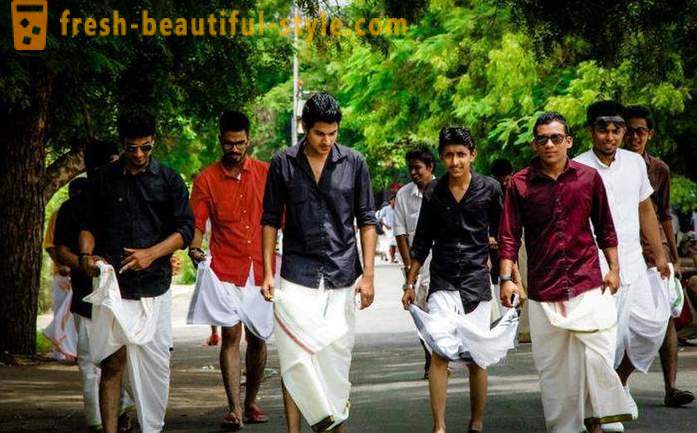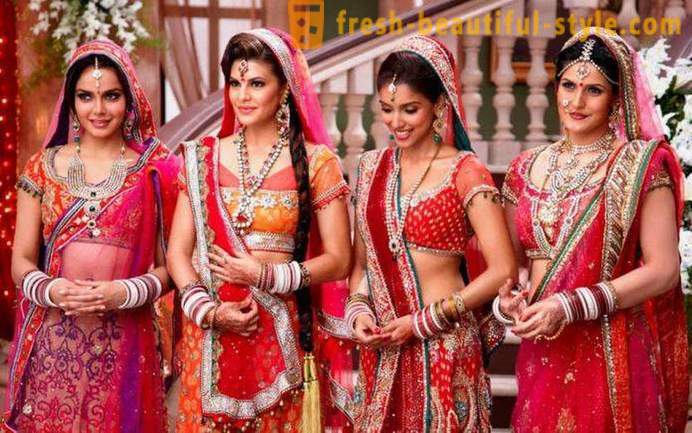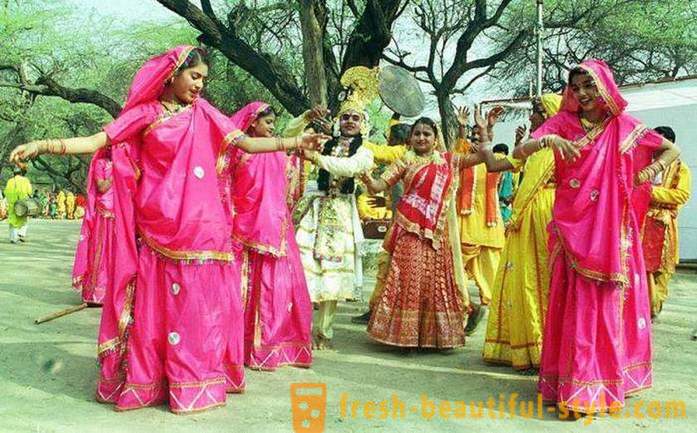Indian costume. Traditional India Clothes
Indian culture is unique and original, and the national costume of the inhabitants of the eastern region always attract the eye with their beauty and uniqueness. India - one of the few countries in the world, which are stored in your clothing national color. If all over the world men and women wear the same clothes, with no distinguishing features of the country, the Indian costume is still an integral part of the life of this land mansions.

A bit of history
First of draped fabric (prototype sari) dates back to the Indian civilization existed in the third millennium BC. There are several versions of the scientific and legends associated with its origin. According to one of these legends it is believed that the first sari weaver created a wizard, dreaming about a certain woman, by passing the fabric its luster, softness and tenderness. But some historians argue that the dhoti (male clothing variety) came first, and until the XIV century it was worn by both men and women. A women wearing saris tselnotkanogo become a tradition a little later, when the Indian costume began to take on different characteristics, indicating the sex of the wearer. Disagreement historians also refer to these parts of women's clothing in India as a choli and Lenga (skirt). Some attribute the appearance of these elements with the colonization of India Puritan England and imposed its chaste form of a woman. Others argue that the earlier prototypes of these elements in a variety of bandages on his chest were part of the Indian women's national dress.

Men's national dress
The Indian men's suit for a long time and now consists of a dhoti and shirt. Dhoti is a long piece of fabric, for about two to five meters, which wraps around the hips and passed between the legs. Shirts are usually long and belted, sometimes even below the knee. Also suit may include all kinds of raincoats and capes. Depending on the social status of men dhoti vary in length, and the material from which they are made. Members of the lower castes are short dhoti, which is convenient for work made of cotton fabric. Linen and silk worn by the rich upper-caste. Their dhoti can be very long. And in some regions of India, this type of clothing is worn a little differently and has a kind of skirt with the smell. Dhoti can wear everything, regardless of age and social status. Of course, many men prefer to India modern clothes, relevant to its time, but the national costume does show that its support is conservative and is committed to the cultural values of their country.

The cornerstone
If men are all quite simple, with the female part of the population is much more difficult due to the variety of types and elements. The main traditional Indian women's costume - a sari. The width of this tselnotkanogo cut is a little more than a meter, and the length can reach four to nine meters. In Sanskrit sari - a strip of cloth. But this strip can be a whole work of art, because every woman it is a handwork embroidered with gold thread, beads, appliques. Styles and ways of wrapping sarees to depend on many factors, such as time and place of residence, daily or celebration, as well as the fantasy of the woman. But the most common way - it's "nivi" when one end of the fabric is wrapped several times on the thighs, and the other is thrown over his shoulder, and fixed on the skirt. The free part of the sari rushes down when a woman is on the street.
A short blouse or a "choli"
None indian costume for a woman is not complete without a choli. This element is an analog of the usual topic - or rather, a short tight blouse with short sleeves. But modernity is still left its mark on the Indian tradition, and now may be a choli and long sleeves or straps, as well as at all without sleeves. Choli is worn not only in tandem with the sari is also interesting option and formal wear Lang-choli. Sarees can also be both everyday and festive, but Lang-choli - this is another kind of traditional Indian women's attire.

Clothing for special occasions
Lang-choli has several names - hagra-choli, Gagra Choli, Chania-choli - and disseminated not only in India but also in Pakistan and even in southern Afghanistan. In addition to directly short blouses, suit this Indian also includes Lang (lehenga) and dupatta. Leung traditionally is in the form of an umbrella skirt whose length varies depending on the social status of the woman. The upper classes are only long Leng. Dupatta in the past also had the privilege of women from higher castes, but in today's world it has become a part of the festive attire of any Indian. Only red Lang-choli previously considered traditional suit for the wedding, but now the bride can choose any color for your celebration. And a variety of tissues and at all is amazing: silk, satin, brocade, organza, linen, velvet - this is just a small list, which also decorate them with embroidery, beads, and sequins. But for lower classes are preferably cotton Leng-Chol embroidered, sometimes slices decorated mirrors.

Indian costume for the dance
For some of the traditional dances such as hagra, bellydance, Indian women also wear Lang-choli. But for the performance of other classical Indian dances chosen, and other types of suits. In addition to the universal sari, there are some of these species, such as the suit as "pajamas", which was first seen on the famous dancer in Bharatanatyam style. Rukmini Devi Arundale It is considered the creator of this style, which is sewn from a sari. To suit chosen bright colors and the fabric itself is decorated with a border of gold thread called Dawn. Embroidery (dawn Buttoud) may also be the main part of the fabric. The components of attire: Ravick (blouse), dhavani (bib), kacham (trousers with nabedrennik) and visiri (pleating, attached to the pants). But this is only one of the most common options, because each dancer's own original approach to their stage costumes.

How do dress up Indian children?
Clothing younger generation in India is almost no different from the adult counterparts. Boys can wear as a dhoti and trousers, shirts, capes and shirts. Indian costume for girls looks like polusari and includes Leung choli and tippet, which creates a semblance of a full sari. But this is only the traditional outfit for the girl, then she can choose something more modern and in everyday life.












































